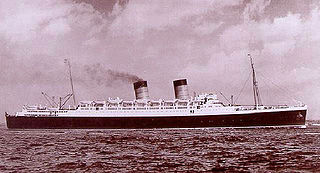
The RMS Mauretania was an ocean liner that was launched on 28 July 1938 at the Cammell Laird yard in Birkenhead, England, and was completed in May 1939. She was one of the first ships built for the newly formed Cunard-White Star company following the merger in April 1934 of the Cunard and White Star Line. On the withdrawal of the first Mauretania in 1935, to prevent a rival company using the name and to keep it available for the new liner, arrangements were made for the Red Funnel paddle steamer Queen to be renamed Mauretania in the interim.
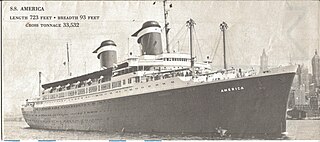
SS America was an ocean liner and cruise ship built in the United States in 1940 for the United States Lines and designed by the noted American naval architect William Francis Gibbs. It carried many names in the 54 years between its construction and its 1994 wreck: SS America ; troop transport USS West Point; and SS Australis, Italis, Noga, Alferdoss, and American Star. It served most notably in passenger service as America and the Greek-flagged Australis.
Italian Line and from 1992 Italia Line, whose official name was Italia di Navigazione S.p.A., was a passenger shipping line that operated regular transatlantic services between Italy and the United States, and Italy and South America. During the late 1960s the company turned to running cruises, and from 1981 it became a global freight operator.

The SS Mongolia was a steam turbine-driven twin-screw passenger-and-cargo ocean liner launched in 1922 for the Peninsular and Oriental Steam Navigation Company (P&O) for service from the United Kingdom to Australia. Later in P&O service she sailed for New Zealand, and in 1938 she was chartered to a P&O subsidiary, the New Zealand Shipping Company, as SS Rimutaka.

SS Argentina was a US turbo-electric ocean liner. She was completed in 1929 as SS Pennsylvania, and refitted and renamed as SS Argentina in 1938. From 1942 to 1946 she was the War Shipping Administration operated troopship Argentina. She was laid up in 1958 and scrapped in 1964.
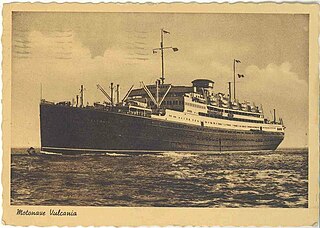
The MS Vulcania was an Italian ocean liner built by Cantiere Navale Triestino, Monfalcone, northern Italy, in 1926 for the Italian company, Cosulich Line.

SS Conte Rosso was an Italian transatlantic ocean liner that was built in Scotland in 1921–22, became a troop ship in the 1930s and was sunk by HMS Upholder in 1941.
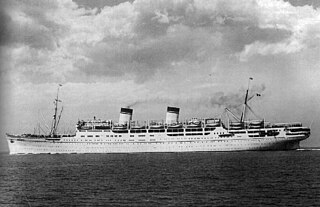
SS Conte Grande was a Lloyd Sabaudo ocean liner built in 1927 by Stabilimento Tecnico Triestino in Trieste, Italy, to service the transatlantic passenger line between Genoa, Italy, and New York City. Launched on 29 June 1927, her maiden voyage was from Genoa to Naples to New York City, which occurred on 13 April 1928. In 1932, after acquisition by the Italian Line, she was transferred to the South America service but was laid up in Santos, Brazil in 1940.

Conte Verde was an Italian ocean liner active in the early 20th century.

USS General George M. Randall (AP-115) was a General John Pope class troop transport which served with the United States Navy in World War II and the postwar era. She was named after Major General George Morton Randall, an American Civil War hero, and veteran of the Indian wars of the 1880s and the Philippines in the early 1900s.

RMS Sylvania was an ocean liner built in 1957 by John Brown & Co (Clydebank), in Glasgow, for the United Kingdom-based shipping company Cunard Line. She was the last Cunard Line vessel built specifically for transatlantic crossings. The ship was later heavily rebuilt as a cruise ship, and sailed under the names SS Fairwind, SS Sitmar Fairwind, SS Dawn Princess and SS Albatros before being scrapped in 2004. She was renamed SS Genoa for her last voyage.

The Lloyd Sabaudo was a Shipping transport line formed in Turin in 1906. It began passenger service in 1907, expanding to link Italy to ports in Asia as well as North and South America. In 1932 it merged with several other Italian shipping lines to form the Italian Line.

SS Re d'Italia was an Italian ocean liner for Lloyd Sabaudo named for the King of Italy. Launched in 1906, she sailed between Italy and New York and South America for most of her career. During World War I she was employed as a troopship carrying United States troops to France as part of the United States Navy Cruiser and Transport Force. She was scrapped in 1929.

MS Giulio Cesare was a luxurious ocean liner built for the Italian Line. She was a sister ship to MS Augustus which was launched in the same year. She was built for the South America service like her sister. These two ships' specification and design were very similar.

Lavia was a cruise ship that caught fire and sank in Hong Kong Harbour in 1989. She was built for Cunard White Star Line in 1947 as the cargo liner Media. In 1961 she was sold to Italy, rebuilt as an ocean liner and renamed Flavia. In 1969, she was refitted as a cruise ship and renamed Flavian. In 1982 she was sold to Panama and renamed Lavia. She was undergoing a refit when the fire occurred. The damage to her was so great that she was scrapped.
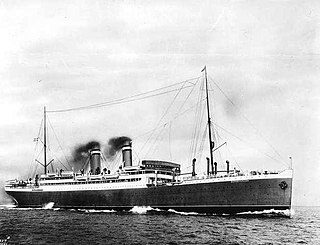
SS Bergensfjord was a Norwegian ocean liner that sailed for the Norwegian America Line to the United States. During the Second World War she was requisitioned by the British Ministry of War Transport and used as a troop ship. After the war she continued sailing as a Trans-Atlantic passenger liner, first for South American owners, then for an Israeli company.
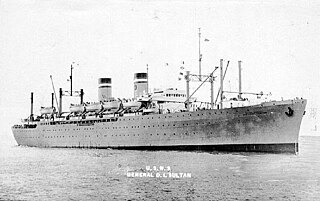
USS Admiral W. S. Benson (AP-120) began as an unnamed transport, AP-120, that was laid down on 10 December 1942 at Alameda, California by the Bethlehem-Alameda Shipbuilding Corp., under a Maritime Commission contract. She was named Admiral W. S. Benson (AP-120) on 20 October 1943 and launched on 22 November 1943; sponsored by Miss Dorothy Lucille Benson, granddaughter of the late Admiral William S. Benson. She was accepted from the Maritime Commission on 23 August 1944 and commissioned the same day.

USS Admiral E. W. Eberle (AP-123) was laid down on 15 February 1943 under a Maritime Commission contract by the Bethlehem Shipbuilding Corporation, Alameda, California; launched on 14 June 1944; sponsored by Mrs. Earl Warren, the wife of the Governor of California who later became Chief Justice of the United States Supreme Court; and acquired by the Navy and commissioned on 24 January 1945.

SS Katoomba was a passenger steamship that was built in Ireland 1913, spent most of her career in Australian ownership and was scrapped in Japan in 1959. McIlwraith, McEacharn & Co owned her for more than three decades, including two periods when she was a troopship. In 1946 the Goulandris brothers bought her for their Greek Line and registered her in Panama. In 1949 she was renamed Columbia.

Ebe is a former training ship of the Italian Navy. Initially a merchant vessel named San Giorgio, she was acquired by the Navy and used to train non-commissioned officers between 1952 and 1958. Since 1963 she has been preserved and exhibited at the Museo Nazionale Scienza e Tecnologia Leonardo da Vinci in Milan.

























